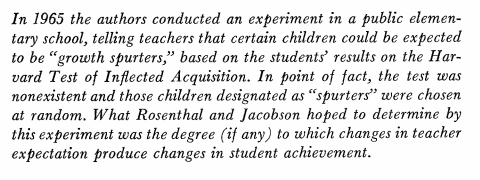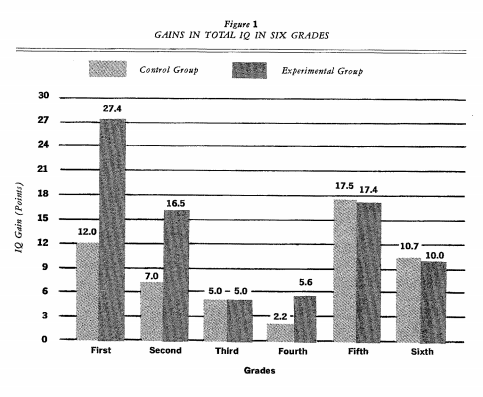In 1965 a pair of researchers, Robert Rosenthal and Lenore Jacobson, set out to study the Pygmalion Effect, which hypothesizes that if we hold high expectations for people’s performance, their performance will be better than if we hold low expectations.

Rosenthal & Jacobson, 1968
What they found was startling, especially for younger kids. Students who had been randomly selected as being likely to show potential based on an imaginary test and then this information communicated to their teachers, showed tremendous gains in the intellectual ability compared to the control group.

Rosenthal and Jacobson, 1968
The reverse effect, called the Golem Effect, has also found to have an impact through randomized-control-sample experimental design. This means that one factor into student performance is the expectations teachers have, either high or low, on that student performance.
Every time you refer to your students as “low kids” you are re-enforcing expectations of future achievement that limit children. #NCSM16
— David Wees (@davidwees) April 12, 2016
This is why I get incredibly frustrated when teachers use labels like “high” or “low” to describe their students. Invariably these labels are like self-fulfilling prophesies that lead to strengthening or weakening student beliefs about their own ability to be successful and lead to teachers, subconsciously, taking actions that lead to either higher or lower student performance, and as performance is related to student learning, this can be devastating.
Of course, this pernicious labeling of students is built right into our systems of education so we can hardly consider individual teachers to be at fault. We have the ELL students, the SpEd students, the “lower third”, the students who only achieved a 1 or a 2 on the NY state exam, the students who failed algebra last semester, and other unhelpful labels for students ad nauseam.
So what do we do? I propose a good starting place is to eliminate unhelpful labels from our own vocabulary. Another step is to talk to our colleagues about our shared use of labels for students. Find ways to look for and talk about strengths in students rather than perceived deficits.
David Butler says:
I think one way to deal with this in a classroom setting is to stop saying to yourself/others “How do I help my lower third succeed?”, and instead say “How do I help everyone succeed?” or “How do I help Jo succeed?”
April 29, 2016 — 3:03 pm
David Wees says:
Hi David,
Yeah, thinking of how to support individuals or everyone is much better IMHO than trying to categorize students as being like other students in some way that is meaningful or not really arbitrary.
Dave
May 2, 2016 — 1:17 am
John Golden says:
So glad to have a description of this effect and research for my PSTs. Thanks!
May 1, 2016 — 8:41 pm
David Wees says:
Great! There’s more research linked from the Wikipedia pages and I’m sure even more (up to date) research in ERIC.
Dave
May 2, 2016 — 1:17 am
Robin Schwartz says:
Without any reference to this study, I surveyed my PSTs elem level on what to call the IEP s’s. This was what they said:
S’s who need extra help
anything but retarded
s’s in need of more support (3)
s’s w special needs
S’s w disabilities
S’s with Learning Differences
s’s with greater needs
s’s with intellectual disabilities
s’s who are struggling
s’s with Learning Disabilities
On Weds, we will read this blog post together and discuss some possible ‘positive’ labels
Thank you for shedding light on this!!
May 2, 2016 — 6:32 pm
David Wees says:
How did this conversation go?
May 10, 2016 — 11:07 am
Trevor Green says:
It has to be noted that kids are not stupid, and they will notice a Teacher’s categorizations even if they aren’t labeled directly. They will see when other students are praised, they will note when the Teacher has to explain something to them more than once. They will self categorize. So while it is great to not directly sabotage a child’s self perception the job is probably a bit harder than that.
I would contend that until we remove the Teacher as a barrier to achievement we are going to continue to have these issues. A child that is self identifying that they are less than or struggling needs to be encouraged to find a real way to earn praise. Because they will eventually identify false praise and continue to struggle to establish a personal identity that drives them to success.
How do we remove the teacher as a barrier? With technology that allows the students to catch up and/or move ahead on their own without permission. So that students that are struggling have a way to catch up that doesn’t require permission or interactions with the Teacher or peers that will further erode their sense of self.
Once we have moved all basic instruction online students can go to a school environment knowing that they own their education. That with or without, quality, in person Teachers, they have the tools for success in front of them 24/7 and don’t need to fear that they are in front of, or behind other students. That they just need to sit down and do the work and some days they are behind someone, other days they are ahead, but always they are able to continue to strive for success and reach goals outside of the arbitrary restrictions of time, and location based education and it’s outmoded (and damaging) grouping of students.
May 3, 2016 — 11:56 pm
David Wees says:
I don’t think this is the problem. The Khan Academy has been around for nearly 10 years now and has not one study showing that it is more effective than a teacher. A recent meta-analysis of online learning for teens across the country showed that a year of study online (at the high school level) was exactly the same impact as if the kids had not been in school at all and instead watched TV the whole year.
May 10, 2016 — 11:05 am